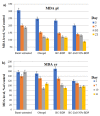Wound Healing Composite Materials of Bacterial Cellulose and Zinc Oxide Nanoparticles with Immobilized Betulin Diphosphate
- PMID: 33809076
- PMCID: PMC8000300
- DOI: 10.3390/nano11030713
Wound Healing Composite Materials of Bacterial Cellulose and Zinc Oxide Nanoparticles with Immobilized Betulin Diphosphate
Abstract
A design of new nanocomposites of bacterial cellulose (BC) and betulin diphosphate (BDP) pre-impregnated into the surface of zinc oxide nanoparticles (ZnO NPs) for the production of wound dressings is proposed. The sizes of crystalline BC and ZnO NPs (5-25%) corresponded to 5-6 nm and 10-18 nm, respectively (powder X-ray diffractometry (PXRD), Fourier-infrared (FTIR), ultraviolet (UV), atomic absorption (AAS) and photoluminescence (PL) spectroscopies). The biological activity of the wound dressings "BC-ZnO NPs-BDP" was investigated in rats using a burn wound model. Morpho-histological studies have shown that more intensive healing was observed during treatment with hydrophilic nanocomposites than the oleophilic standard (ZnO NPs-BDP oleogel; p < 0.001). Treatment by both hydrophilic and lipophilic agents led to increases in antioxidant enzyme activity (superoxide dismutase (SOD), catalase) in erythrocytes and decreases in the malondialdehyde (MDA) concentration by 7, 10 and 21 days (p < 0.001). The microcirculation index was restored on the 3rd day after burn under treatment with BC-ZnO NPs-BDP wound dressings. The results of effective wound healing with BC-ZnO NPs-BDP nanocomposites can be explained by the synergistic effect of all nanocomposite components, which regulate oxygenation and microcirculation, reducing hypoxia and oxidative stress in a burn wound.
Keywords: antioxidant properties; bacterial cellulose; betulin diphosphate; burns; wound dressings; zinc oxide nanoparticles.
Conflict of interest statement
The authors declare no conflict of interest.
Figures













Similar articles
-
The Effect of Betulin Diphosphate in Wound Dressings of Bacterial Cellulose-ZnO NPs on Platelet Aggregation and the Activity of Oxidoreductases Regulated by NAD(P)+/NAD(P)H-Balance in Burns on Rats.Molecules. 2021 Sep 9;26(18):5478. doi: 10.3390/molecules26185478. Molecules. 2021. PMID: 34576949 Free PMC article.
-
The New Pharmaceutical Compositions of Zinc Oxide Nanoparticles and Triterpenoids for the Burn Treatment.Pharmaceuticals (Basel). 2020 Aug 22;13(9):207. doi: 10.3390/ph13090207. Pharmaceuticals (Basel). 2020. PMID: 32842689 Free PMC article.
-
Zinc Oxide Nanoparticles Protected with Terpenoids as a Substance in Redox Imbalance Normalization in Burns.Pharmaceuticals (Basel). 2021 May 21;14(6):492. doi: 10.3390/ph14060492. Pharmaceuticals (Basel). 2021. PMID: 34064301 Free PMC article.
-
An overview on antimicrobial and wound healing properties of ZnO nanobiofilms, hydrogels, and bionanocomposites based on cellulose, chitosan, and alginate polymers.Carbohydr Polym. 2020 Jan 1;227:115349. doi: 10.1016/j.carbpol.2019.115349. Epub 2019 Sep 21. Carbohydr Polym. 2020. PMID: 31590840 Review.
-
Cellulose from sources to nanocellulose and an overview of synthesis and properties of nanocellulose/zinc oxide nanocomposite materials.Int J Biol Macromol. 2020 Jul 1;154:1050-1073. doi: 10.1016/j.ijbiomac.2020.03.163. Epub 2020 Mar 19. Int J Biol Macromol. 2020. PMID: 32201207 Review.
Cited by
-
Bacterial Cellulose (BC) and BC Composites: Production and Properties.Nanomaterials (Basel). 2022 Jan 7;12(2):192. doi: 10.3390/nano12020192. Nanomaterials (Basel). 2022. PMID: 35055211 Free PMC article.
-
The Effect of Betulin Diphosphate in Wound Dressings of Bacterial Cellulose-ZnO NPs on Platelet Aggregation and the Activity of Oxidoreductases Regulated by NAD(P)+/NAD(P)H-Balance in Burns on Rats.Molecules. 2021 Sep 9;26(18):5478. doi: 10.3390/molecules26185478. Molecules. 2021. PMID: 34576949 Free PMC article.
-
Engineered Nanotechnology: An Effective Therapeutic Platform for the Chronic Cutaneous Wound.Nanomaterials (Basel). 2022 Feb 25;12(5):778. doi: 10.3390/nano12050778. Nanomaterials (Basel). 2022. PMID: 35269266 Free PMC article. Review.
-
Zinc Oxide Nanoparticles Exhibit Favorable Properties to Promote Tissue Integration of Biomaterials.Biomedicines. 2021 Oct 13;9(10):1462. doi: 10.3390/biomedicines9101462. Biomedicines. 2021. PMID: 34680579 Free PMC article.
-
Emerging nanomaterials for novel wound dressings: From metallic nanoparticles and MXene nanosheets to metal-organic frameworks.Heliyon. 2024 Oct 22;10(21):e39611. doi: 10.1016/j.heliyon.2024.e39611. eCollection 2024 Nov 15. Heliyon. 2024. PMID: 39524817 Free PMC article. Review.
References
-
- Vorobyova O., Deryabina O., Malygina D., Plotnikova N., Solovyeva A., Belyaeva K., Melnikova N. Betulin-3,28-diphosphate as a Component of Combination Cytostatic Drugs for the Treatment of Ehrlich Ascites Carcinoma In Vitro and In Vivo Experiments. Sci. Pharm. 2018;86:17. doi: 10.3390/scipharm86020017. - DOI - PMC - PubMed
Grants and funding
LinkOut - more resources
Full Text Sources
Other Literature Sources
Medical

